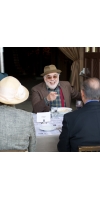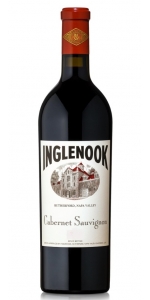Wine from Inglenook

Inglenook covers approximately 1,700 contiguous acres with nearly 235 acres dedicated to vineyards. The variations in the Estate's topography reflect the great diversity of Napa Valley itself–-from the loamy, well-drained soils at its rear to an expanse of vineyards with deeper, but finer soils located in front of the Chateau–-and contribute to the singularity of Inglenook's terroir, a complex term incorporating the natural growing conditions of the specific site as well as the winemaker's signature––with some ineffable quality arising from the two–-which distinguish the wine's personality as unique.
Francis Ford Coppola is best known as the six-time Academy Award-winning director of such epic films as The Godfather trilogy and Apocalypse Now. As a writer, director, and producer, he has been a central figure in contributing to the shape of contemporary American cinema. His creative pursuits run wide, however, and he is one of those rare individuals who can turn his dreams into viable realities, perhaps because of his clarity in seeing life as being full of all the possible ways to tell stories wanting to be told.
The whole of the 1970s was an extraordinary time in his career—writing, directing, and/or producing The Godfather (1972), American Graffiti (1973), The Godfather Part II (1974), The Conversation (1974), and Apocalypse Now (1979), a bevy of films earning him 12 Academy Award nominations, five Academy Awards, and two Palme d'Or awards from the Cannes Film Festival. It was during this same period that Francis embarked on an entirely different venture, to tell an entirely different story that would further develop the course of one of America's most venerable wine estates—Inglenook.
Ever since 1975, when he purchased the major portion of what was then under corporate ownership, Francis vowed to reunite Inglenook's land, the land to its name, and Inglenook's name to its former integrity. He established his own estate winery of Niebaum-Coppola that same year, and produced the first vintage of his flagship red wine, Rubicon, in 1978. More wines were to follow under the Niebaum-Coppola Estate label, with Francis steadily working towards his ultimate goal of "restoring Inglenook to its rightful place in history." In 1995 he bought the remaining part of the original Inglenook property, renovating its Chateau—which had stopped making wine—in both aesthetic appearance and function as a winemaking facility. And then in 2011, after nearly 40-years worth of committed resources and resolve, he acquired Inglenook's name and trademark, making it whole once again—in presence and spirit—with a winemaking approach that now honors its present and future welfare.
An inveterate traveler, Francis always looks to new experiences as sources of insight and, as a way of sharing his delight in exploring foreign sensations—sights, sounds, tastes—has opened several luxury hideaways in Central America, Argentina, and the exceptional Palazzo Margherita in southern Italy. He launched Zoetrope: All-Story, a quarterly magazine of short fiction and one-act plays, in 1997, and is the best-selling author of The Godfather Notebook (2016). Fascinated with the potential of combining theater, film, and television into one art form, he most recently authored Live Cinema and Its Techniques (2017), a book filled with descriptions and discussions of the methods involved in instantaneously broadcasting performance-based productions that retain the spontaneity of a live event. He is presently working on a cycle of screenplays that he intends to produce in this experimental medium.
Inglenook Rubicon is made from 88% Cabernet Sauvignon, 8% Merlot, 3% Cabernet Franc, 1% Petit Verdot
Since its inaugural vintage in 1978, Rubicon has been the Estate's premier red wine, reflecting the soul of the property and expressing Francis Coppola's wish to create a Bordeaux-styled grand wine, that is, "a wine that can please contemporary taste, but with a historical aspect [that defines] our vineyards at their zenith."
Rubicon was named after the small river crossed by Julius Caesar in 49 B.C., declaring his intention to gain control of Rome, thereby launching a civil war among opposing factions. Over time the phrase "crossing the Rubicon" has come to signify any irreversible action with revolutionary intent or the outcome of which holds great risk. True to its uncommon depth, Inglenook's Rubicon continues to be a testament to the finely tuned rendering of a risk well-taken.
Strikingly rich in color and extract, the 2018 Rubicon is unquestionably a precocious, hedonistic wine. The exotic, well-knit aromas and flavors include ripe cassis, allspice, star anise, vanilla and black licorice. Upon entry, this full-bodied wine envelops the palate with its luxurious concentration and supple, silky tannins, supported by vibrant freshness from the balanced acidity, and perfectly-integrated French oak. Very long and expansive in the finish, the 2018 Rubicon will be memorable for decades to come.
Review:
Subtle and complex red with blackberry, black truffle, sweet tobacco and mahogany. Highlights of lavender and violets. Full-bodied and very tight with finesse and tension. Very polished, fine tannins. Long finish. Delicious already, but best after 2022.
-James Suckling 97 Points
Inglenook Rutherford Cabernet Sauvignon is made from 96% Cabernet Sauvignon, 4% Cabernet Franc.
Stunningly deep ruby in color, the 2019 Cabernet Sauvignon opens with heady aromas of brambly black cherry, vanilla, warm brioche, and crème de cassis. As the wine warms on the palate, notes of red cherry, graphite and fennel emerge, as very polished, refined tannins carry the wine into a long, fragrant finish. Layered flavors, good tension, and a perfect integration of wine and oak interact to create this classic expression of Inglenook Cabernet Sauvignon.
Review:
This shows notes of ripe blackberries and blackcurrants with hints of licorice, cloves, walnuts and chocolate. It has full body and a velvety tannin structure. Juicy and vibrant fruit on the palate with a touch of earthiness. Smooth and delicious. Long, fruity finish. Very pure fruit. Try after 2024.
-James Suckling 95 points
- back
Selected Options
Wineries
Categories
Pricing
Countries
Regions
Grape Types
Wineries
Organic/Free Shipping
All older vintage wines have been purchased from a single collectors cellar. Pictures can be requested before shipment.
Nickel & Nickel C.C. Ranch Cabernet Sauvignon is made from 100 percent Cabernet Sauvignon.
VINEYARD DESCRIPTION C.C. Ranch is planted in Rutherford, along the slope of a knoll west of the Silverado Trail. The vineyard grows classic Rutherford Cabernet Sauvignon on well-drained, gravelly loam soil and receives a variety of exposures, depending on the block and location. The vines are well balanced and the canopy is opened up to give good light exposure. Nickel & Nickel produces wine from 15 select acres of this 115-acre vineyard.
HARVEST NOTES The beginning of the 2022 growing season was exceptionally mild, with budbreak kicking off in March. By May, the vines began to demonstrate strong shoot growth and average crop yields ahead of veraison in mid-July. While we welcomed a few heat spikes during the summer months, our proactive approach to vineyard management allowed us to not be negatively impacted and we maintained great quality through heat mitigation preparation, including the use of shade cloths and misting systems, among others. Mild to moderate temps in August created optimal conditions allowing for bright and focused flavors.
SENSORY EVALUATION The 2022 C.C. Ranch Cabernet Sauvignon offers a pure expression of Rutherford, pushing the edge of ripeness while retaining a juicy vibrancy. Concentrated red raspberry and cherry flavors blend beautifully with subtle notes of clove, baking spice, and the signature Rutherford dust. The oak harmonizes with the fruit, adding depth, while vibrant acidity and silky tannins create a layered mouthfeel.
The C.C. Ranch exudes finesse from the very first swirl with lifted plum and floral aromatics opening onto a beautifully plush palate. Ripe raspberry and plum flavors are underscored by seductive spicy notes, with soft tannins gently supporting the wine from entry to completion. With fruit that grows brighter and fresher as the wine progresses to the finish, this Rutherford Cabernet is incredibly approachable now but will continue to age gracefully over time. A finish that lingers well after the last sip.





